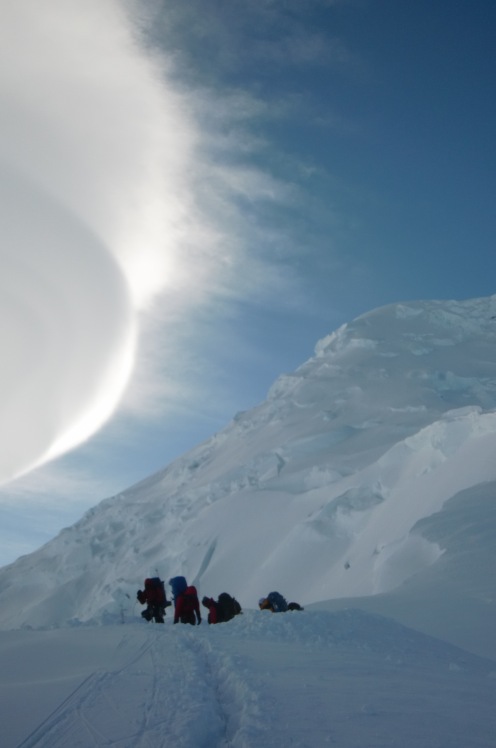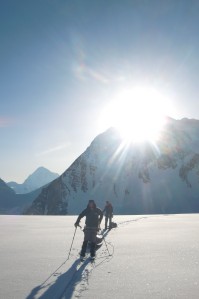
Day 3-4 Tengboche monastery
The venerable Lamas sit crimson robed and spectacled midway between the towering peaks of Everest-Lhotse-Ama Dablam, and the five costumed dancers with their tall hats, colors, bells, and drums. Skips and full spinning turns, clanging cymbals, heavy drums, trumpets and strange yells. A masked jester with big white hair gave a tease of a dance and ran back inside the gompa. Mani Rimdu, an elaborate ritual that commemorates the triumph of Buddhism over Bön, the tribal predecessor.
Perched in the top of a juniper tree, the cymbals and repetitive horn blasts rose up, seemingly amplified by the surrounding alpenglow peaks. A moment that strikes at innermost being, unreal and actual.
In the gathering darkness, twenty women in an arm over shoulder line sing cyclical mantra songs and stomp a rhythmic dance. The silences are filled with the shouts of children playing tag.
A long string of prayer flags flutter in front of me like a rainbow. The horns of the monastery can be heard mingling with the roar of the Imja Khola. The ice and granite of Kantega and Thamserku play with shadow and cloud. Lhotse is cloud-hidden, but Chomolungma and Nupste shine in the sun. My back to the stupa, my bivy unparalleled.
Day 6 Chukhung Ri 5,550m [18,315ft]
A massive piece of hanging glacier on the Nupste face across from my perch cracked off—the billowing clouds and waterfall-like snow pummeled down the face to a cone of avalanche debris. Lhotse and Makalu reveal granite faces, and a series of stunning down valley peaks sweep around to Cho Oyu. Clear blue sky slides down to endless fluted ridges. Ineffable mountain beauty.
“In the mountains worldly attachments are left behind, and in the absence of material distractions, we are opened up to spiritual thought. When we look out at the ocean or gaze at the sky and clouds, or even the rock wall of a mountain, it is difficult for our minds to form labels. What is it really that we are looking at? There is no real thing there—just color and shape. And when we stop attaching labels to what we see, a sense of quietness flows in to fill the gap, bringing us a step closer to the understanding of emptiness.”
-Jamling Tenzing Norgay

Day 8 Everest Base Camp and Kala Pattar [18,400ft]
The snow flutes on Nupste’s face formed a thousand sunset cathedrals. Sagarmatha captured the last red light. Ama Dablam stood like a champion on a pedestal. A cold clear Kala Pattar twilight. Marveled at the icefall from the Khumbu glacier at noon.

Day 13 Gokyo
The yaks are sitting idly by the spring that feeds into Dudh Pokari, the clear water fusing with the turquoise mass to form a sacred lake. There are no ritual immersions as during the Sacred Thread Festival, just the wind ruffling shining riffles below 6,000m Phari Lapche’s snow dusted cliff. The final stage of the Three Passes Trek [Renjo La 5,360m] stands across the lake. The first two having been challenges—acute mountain sickness hitting on the Kongma La from Chukhung as a debilitating headache and slow-motion wobbly daze, and then over the icy Cho La while recovering from a feverish food poisoning/virus episode in Dzonglha—I hope to be strong and healthy for Renjo.

Watching the sunset on four of the tallest mountains on earth from Gokyo Ri—the sky a bruised purple-pink behind stark summits of grey and white looming over an impenetrable cloud bank— a moment of unfathomable upness. Such sights empower, enlighten, and annihilate simultaneously. The humbled self is no more, elevated into the staggering All of it all. The throbbing cranium pressure, lack of air, tortuous fever dreams, and bodily voiding that occurred to get here become worthwhile and necessary. I am not there, I am here, everywhere—content and still.

Jamling Norgay, the son of the first to summit Everest, has more to say about bringing mountain being into everyday life:
“When climbing, the presence of mind that one needs in dangerous situations makes one naturally undistracted, and that undistractedness is what generates awareness and a feeling of being completely alive. Every action becomes meaningful because each movement is a matter of life and death.
In a sense, anyone who intentionally travels into the mountains is on a pilgrimage to Miyolangsangma [goddess of Everest] and the other Five Long Life Sisters. But theoretically, we shouldn’t need to go to the mountains to visualize them and make offerings to them. We should be attempting to carry the spiritual experience of the mountains with us everywhere.
When we return to normal surroundings, the mundane can begin to feel like something of a meaningless state. We need to return to the mountains to feed that liberating experience, because we depend on external landscapes and events to aid our understanding. Rather than allowing the quality of being fully present, fully aware, to develop around us at all times—and in a safer environment—we become addicted to a certain quality of circumstance and experience. In effect, Buddhists suggest that climbers might focus on the substance of their pursuit—awareness and liberation—rather than on the setting they feel they need to be in for it to occur.”
Well said, and something to aspire to.
Day 14 Cho Oyu Base Camp Bivy
I watched the cloud shadows move up the rock, morphing in slow motion. A new height towering above the sixth lake [Ngozumba Mountain], the mass of Cho Oyu’s grey glacier out in front. Clear new views from Makalu over. Quiet besides the crack of avalanche, I feel I can nearly hear the hum of the Himalayan sisters.
Rock garden bivy—mist rolling in, ridges lit, wind dead. Frost already gathering on my bag below luminous mountains. Yak cheese and ginger biscuits. Lake ice lasers ping. I must get my hands inside.
I awake to the sliver moon and the evening star, the white outlined peaks set off by the stars. Cold. Rock in thigh. I lay, observing the sky lighten.
Day 16 Renjo La [5,360m]
Wisps of cloud beginning to blossom in the blue above the peaks. The dusting of snow in Gokyo made for a sparkling path to the pass. The hulk of Nuptse, Lhotse, and Everest dominates the skyline vision. Stillness—only the Sherpas calling jovially up and down. One of the condor-eagles appears, soaring towards me and circling for many minutes against an unfathomable backdrop. If I were he and he were me…
How grateful I am to have seen these sights, to have been immersed in the Himalaya. A dream fulfilled.
Down to Namche, Lukla, Kathmandu, and then London.
Posted in SHP Letter
Tags: outdoors



















